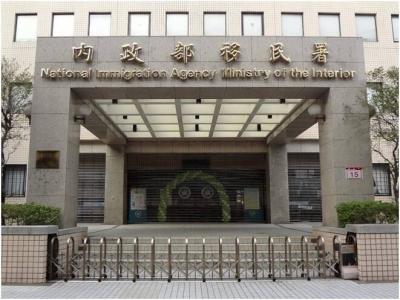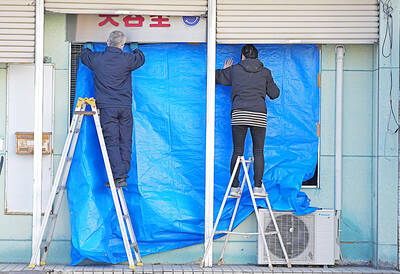Second doses of the XBB.1.5-adapted COVID-19 vaccine are available for people aged 65 or older, indigenous people aged 55 to 64 and immunocompromised people aged six months or older, the Centers for Disease Control (CDC) said yesterday.
The policy was implemented in accordance with an Advisory Committee on Immunization Practices’ resolution, it said.
Vaccine-induced immunity wears off and age is correlated with a weaker immune response, the CDC said, adding that empirical studies suggest that getting a second dose of an XBB.1.5-adapted vaccine can boost immunity, effectively protecting against symptoms and hospitalization from COVID-19.

Photo: Lin Hui-chin, Taipei Times
At an event at the CDC building in Taipei to promote vaccination, 80-year-old actress Wang Man-chiao (王滿嬌) spoke as an ambassador for the agency and received a booster shot to encourage elderly people to get the second dose.
Deputy Minister of Health and Welfare Chou Jih-haw (周志浩) said that although the COVID-19 outbreak has slowed, the risk of hospitalization and death from infection still exists.
More than 90 percent of people in Taiwan who have been hospitalized or died from the disease had not gotten the XBB.1.5-adapted vaccine, while about 60 percent of people hospitalized and about 90 percent of people who died from COVID-19 were elderly, Chou said.
Immunity from the original vaccines or the bivalent Omicron BA.4/BA.5-adapted vaccines has likely waned and cannot protect against the latest strains, Chou said, adding that the XBB.1.5-adapted vaccine gives adequate protection, so those who are eligible should get vaccinated.
Advisory Committee on Immunization Practices head Lee Ping-ing (李秉穎) said SARS-CoV-2 consistently mutates and COVID-19 is expected to become a common illness, but while the incidence rates of serious COVID-19 and fatality have reduced, it still poses a serious risk to elderly and immunocompromised people.
Eligible recipients can get a second dose of the XBB.1.5-adapted vaccine at least 12 weeks (84 days) after the first dose and they can get the same dose or a different brand from their first dose, Lee said.
Immunocompromised people include cancer patients who have received immunosuppressive treatment within a year, people who have undergone organ or stem cell transplant procedures, people with congenital immunodeficiencies, people with HIV, people who are taking immunosuppressive drugs, people who have had chemotherapy or radiotherapy within six months, and those assessed as immunodeficient or immunocompromised by a doctor.
Meanwhile, CDC Epidemic Intelligence Center Director Guo Hung-wei (郭宏偉) said that 81,921 hospital visits for flu-like illness, 16 severe flu complications and two flu-related deaths were reported last week.
CDC physician Lin Yung-ching (林詠青) said that a six-year-old boy and a six-year-old girl were among those with serious complications.
The boy developed neurologic complications, including being unable to understand instructions and a speech disorder, and was being treated in an intensive care unit, Lin said.
There were 6,732 hospital visits for enterovirus infections last week, up 9.4 percent from the previous week and the most for the same week in the past 10 years, Guo said.
The main variants circulating in the past four weeks were group A coxsackieviruses, but five cases of enterovirus 71 and a case of enterovirus D68 — two strains that have been associated with more serious complications — have also been reported, he said.
CDC Deputy Director-General Tseng Shu-hui (曾淑慧) said that an agency simulation estimated that the number of weekly hospital visits for enterovirus infection might exceed the epidemic threshold by the end of the month, while weekly cases are likely to peak next month.
Enteroviruses are highly contagious, especially among family members and at places where people have frequent close contact, so caregivers at nurseries, preschools and schools, as well as parents, should instruct children to practice good cough etiquette and hand hygiene, and pay close attention to their symptoms for signs of serious complications if they are infected, Tseng said.

A small number of Taiwanese this year lost their citizenship rights after traveling in China and obtaining a one-time Chinese passport to cross the border into Russia, a source said today. The people signed up through Chinese travel agencies for tours of neighboring Russia with companies claiming they could obtain Russian visas and fast-track border clearance, the source said on condition of anonymity. The travelers were actually issued one-time-use Chinese passports, they said. Taiwanese are prohibited from holding a Chinese passport or household registration. If found to have a Chinese ID, they may lose their resident status under Article 9-1

Taiwanese were praised for their composure after a video filmed by Taiwanese tourists capturing the moment a magnitude 7.5 earthquake struck Japan’s Aomori Prefecture went viral on social media. The video shows a hotel room shaking violently amid Monday’s quake, with objects falling to the ground. Two Taiwanese began filming with their mobile phones, while two others held the sides of a TV to prevent it from falling. When the shaking stopped, the pair calmly took down the TV and laid it flat on a tatami mat, the video shows. The video also captured the group talking about the safety of their companions bathing

A classified Pentagon-produced, multiyear assessment — the Overmatch brief — highlighted unreported Chinese capabilities to destroy US military assets and identified US supply chain choke points, painting a disturbing picture of waning US military might, a New York Times editorial published on Monday said. US Secretary of Defense Pete Hegseth’s comments in November last year that “we lose every time” in Pentagon-conducted war games pitting the US against China further highlighted the uncertainty about the US’ capability to intervene in the event of a Chinese invasion of Taiwan. “It shows the Pentagon’s overreliance on expensive, vulnerable weapons as adversaries field cheap, technologically

Starting on Jan. 1, YouBike riders must have insurance to use the service, and a six-month trial of NT$5 coupons under certain conditions would be implemented to balance bike shortages, a joint statement from transportation departments across Taipei, New Taipei City and Taoyuan announced yesterday. The rental bike system operator said that coupons would be offered to riders to rent bikes from full stations, for riders who take out an electric-assisted bike from a full station, and for riders who return a bike to an empty station. All riders with YouBike accounts are automatically eligible for the program, and each membership account